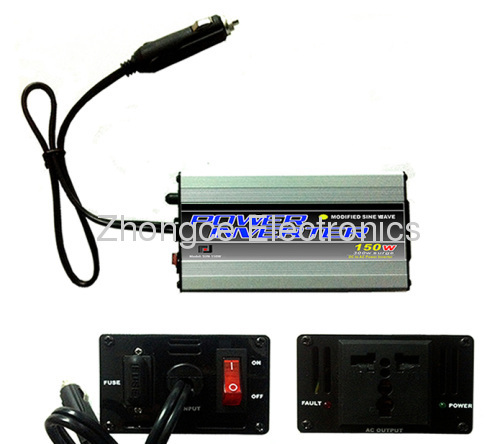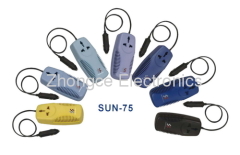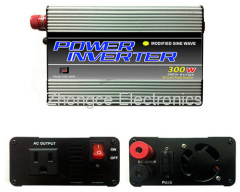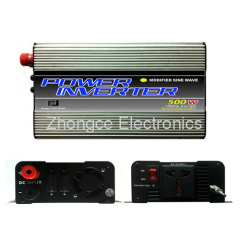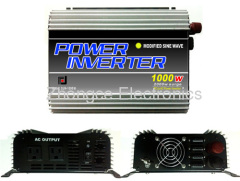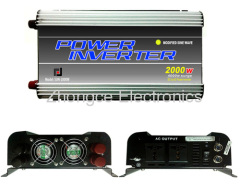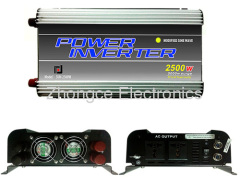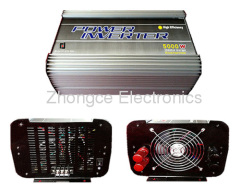|
Ningbo Zhongce Electronics Co.,Ltd.
|
SUN-150 Power Inverters
| Payment Terms: | T/T,L/C,D/A,D/P,WU |
| Place of Origin: | Zhejiang, China (Mainland) |
|
|
|
| Add to My Favorites | |
| HiSupplier Escrow |
Product Detail
thermal protection
low voltage alarm/cut off
high voltage cut off
over load protection
Modified Power Inverter
Designed with advanced conversion technology, SUN-Series Power Inverter is one of the most advanced DC to AC inverters. It can be widely used in vehicles, trains, vessels, solar energy and wind energy generating electricity, mobile office, telecommunications, police and other rush to deal with emergency situations. SUN Power Inverter is of small size, less weight, and easy to use and causes less noise while working. SUN Power Inverter can work safely and smoothly for many years.
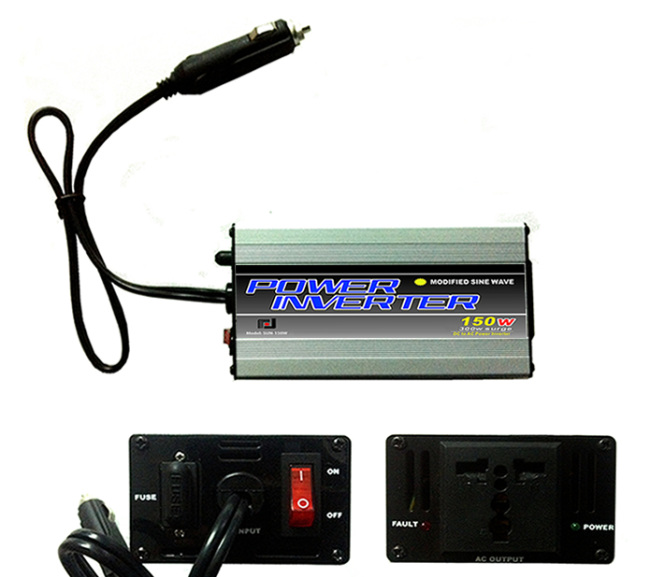
Designed with advanced conversion technology, SUN-Series Power Inverter is one of the most advanced DC to AC inverters. It can be widely used in vehicles, trains, vessels, solar energy and wind energy generating electricity, mobile office, telecommunications, police and other rush to deal with emergency situations. SUN Power Inverter is of small size, less weight, and easy to use and causes less noise while working. SUN Power Inverter can work safely and smoothly for many years.

Applying to electric appliances
Charger of mobile phone, digital and video camera, shaver and so on, and laptop computer, CD/MD/VCD/DVD player, and other lighting electrical appliances whose power are lower than 150W. To assure the efficiency and using safety of the inverter, the total load power should not exceed 90% of the biggest continuous power.
. Do not put the inverter in the raining or humid place, it may cause electric shock.
. Do not insert metals like naked wire into the output socket or inside of the inverter through ventilation hole. Otherwise it may cause electric shock.
. Do not put the inverter in the place where children can reach, it may cause injure and electric shock.
. Keep the inverter from flammable materials, fumes or gases when used.
.. Proper cooling is necessary while operating
..Please insure the inverter is put at "OFF" position when the vehicle is started, otherwise the large instant peak voltage will possibly damage the inverter or its connected electric appliance.
.. Reliable connection of the inverter input and DC output is necessary as the input current is considerable large when inverter is running.
Notice: the signals with .are the operations which may cause the personal security. The signals with .. are the operations which may cause the machine damaging.
Power Inverter is powered by batteries or DC suppliers. For batteries or DC suppliers, the input voltage must be in the prescriptive rage of the inverter input voltage and output current should meet inverter's operation requirement. The detail requirement depends on appliance's output load. If with the battery power supplying, the using time of battery has the relationship with the battery capacity and the size of the load. When the battery is full, the simple calculating method of the using time:
Time (Hour) = Battery capacity (AH) ÷ [Electrical power of using (W) ÷ q (V)], q depends on the battery voltage. Referring to the 12V battery, q = 10; referring to the 24V battery, q = 20. Such as the 12V DC input inverter uses the 12V battery. If the battery capacity is 50AH and at this time the inverter with 50W power load, then in the condition of the battery is full, according to the formula above: the battery use time = 50 (AH) ÷ [100 (W) ÷ 10 (V)] = 5 (Hour). That is batteries can be used for 5 hours.
Security features
Troubleshooting
1. Insert the inverter plug into cigarette light socket.
2. Turn on power switch. If the "Power" indicator is "ON", the Power Inverter works normally. If the "Fault" indicator is on, which means the Power Inverter is failure, check wire connections and appliance load.
3. Operation sequence: When turn on Power Inverter, first turn on Power Inverter and then turn on electric appliance; when turn off Power Inverter, first turn off electric appliance and then turn off Power Inverter.
Specifications (@20 °C)
SUN-150/12-230 | SUN-150/24-230 | SUN-150/12-120 | SUN-150/24-120 | |
Output Continuous Max. Power: | 150W | |||
Output Surge Power | 300W | |||
Converting Max. Efficiency | >85% | >90% | >85% | >90% |
Normal Input Voltage | DC12V | DC24V | DC12V | DC24V |
Input Voltage Range | DC10~15V | DC20~30V | DC10~15V | DC20~30V |
Output Voltage | AC230±5% | AC120±5% | ||
Output Frequency | 50Hz±2% | 60Hz±2% | ||
Output Wave Form | Modified Sine Wave | |||
No Load Current | <0.2A | <0.15A | <0.2A | <0.15A |
Input Under-voltage Cut Off Voltage: | 10±0.5V | 20±0.5V | 10±0.5V | 20±0.5V |
Input Over-voltage Cut Off Voltage: | 15±0.5V | 30±0.5V | 15±0.5V | 30±0.5V |
*: Measuring output voltage, please use the RMS Meter, or there will be errors between measurement and actual value. Idling current is measured under the rated input voltage.
Security features
There is the whole protection and audio-visual alarm system in the internal of SUN-150 power inverter. It can provide a full range of protection, mainly over-voltage protection, under-voltage protection, over-heat protection, overload protection, short circuit protection, reverse polarity protection.
Protection definition:
1.Under-voltage protection: When the input DC voltage is lower than the cut off under-voltage, the power inverter output will be cut off automatically.
2.Overvoltage protection: When the input DC voltage is higher than the cut off under-voltage, the power inverter output will be cut off automatically.
3.Overheat protection: When the internal temperature of power inverter is too high (about 85 ℃), the power inverter output will be cut off automatically.
4.Overload protection: When the power of electric apparatus which was brought by power inverter exceeded its maximum output, the output would be cut off automatically.
5.Short-circuit protection: When the output short-circuits, the power inverter output will be cut off automatically.
6.Reverse polarity protection: When the input positive and negative pole of the power inverter was connected reversed, it will fuse on the cigarette light plug head fuse to protect the internal circuits.
Working environment
1.Operation temperature: -10℃~40℃
2.Storage temperature: -40℃~85℃
3.Considerable air humidity should be less than 85%.
4.No electrical conductivity, dust explosion, corrosion-free gas in the working place.
5.No shock and vibration in the working place.
Physical properties
Size: 172 mm×78 mm×50 mm
Troubleshooting
Fault 1: No AC output
Reason | Solution |
●Vehicle's battery is not on | Turn the vehicle switch to the correct position |
●Connection between battery and the inverter is not well | Check repair or replace the connection or vehicle fuse |
●Low battery voltage | Check battery and charging circuit |
●The appliance's power is over the inverter’s power rating | Appliance’s power should not be over inverter’s power rating |
●Under-voltage protection of the inverter power | Charge the battery and switch it on again |
Fault 2:Low output voltage
Reason | Solution |
●The appliance’s power is over the inverter’s power rating | The appliance’s continuous power should not be over the inverter’s |
●Low battery voltage | Charge battery for enough energy |
.
Didn't find what you're looking for?
Post Buying Lead or contact
HiSupplier Customer Service Center
for help!
Related Search
Power Inverters
Inverters
Sun Power Light
Sun Power Solar
Sun Power Solar Panel
Modified Sine Wave Inverters
More>>

